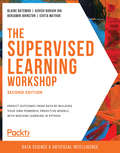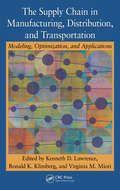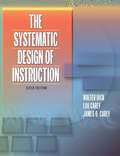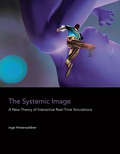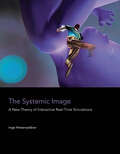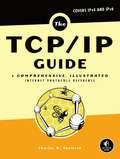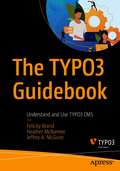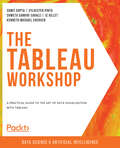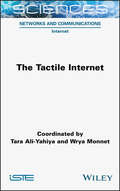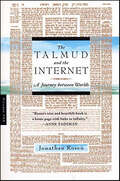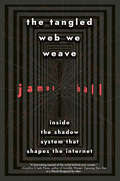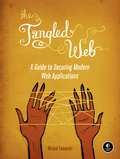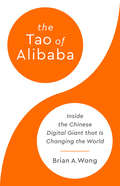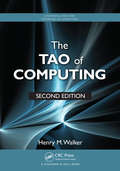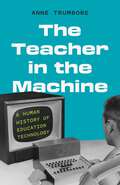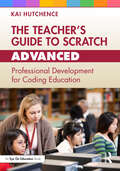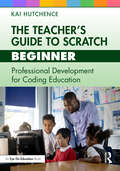- Table View
- List View
The Supervised Learning Workshop: A New, Interactive Approach to Understanding Supervised Learning Algorithms, 2nd Edition
by Benjamin Johnston Ishita Mathur Blaine Bateman Ashish Ranjan JhaCut through the noise and get real results with a step-by-step approach to understanding supervised learning algorithms Key Features Ideal for those getting started with machine learning for the first time A step-by-step machine learning tutorial with exercises and activities that help build key skills Structured to let you progress at your own pace, on your own terms Use your physical print copy to redeem free access to the online interactive edition Book Description You already know you want to understand supervised learning, and a smarter way to do that is to learn by doing. The Supervised Learning Workshop focuses on building up your practical skills so that you can deploy and build solutions that leverage key supervised learning algorithms. You'll learn from real examples that lead to real results. Throughout The Supervised Learning Workshop, you'll take an engaging step-by-step approach to understand supervised learning. You won't have to sit through any unnecessary theory. If you're short on time you can jump into a single exercise each day or spend an entire weekend learning how to predict future values with auto regressors. It's your choice. Learning on your terms, you'll build up and reinforce key skills in a way that feels rewarding. Every physical print copy of The Supervised Learning Workshop unlocks access to the interactive edition. With videos detailing all exercises and activities, you'll always have a guided solution. You can also benchmark yourself against assessments, track progress, and receive content updates. You'll even earn a secure credential that you can share and verify online upon completion. It's a premium learning experience that's included with your printed copy. To redeem, follow the instructions located at the start of your book. Fast-paced and direct, The Supervised Learning Workshop is the ideal companion for those with some Python background who are getting started with machine learning. You'll learn how to apply key algorithms like a data scientist, learning along the way. This process means that you'll find that your new skills stick, embedded as best practice. A solid foundation for the years ahead. What you will learn Get to grips with the fundamental of supervised learning algorithms Discover how to use Python libraries for supervised learning Learn how to load a dataset in pandas for testing Use different types of plots to visually represent the data Distinguish between regression and classification problems Learn how to perform classification using K-NN and decision trees Who this book is for Our goal at Packt is to help you be successful, in whatever it is you choose to do. The Supervised Learning Workshop is ideal for those with a Python background, who are just starting out with machine learning. Pick up a Workshop today, and let Packt help you develop skills that stick with you for life.
The Supply Chain in Manufacturing, Distribution, and Transportation: Modeling, Optimization, and Applications
by Kenneth D. Lawrence Ronald K. Klimberg Virginia M. MioriReporting on cutting-edge research in production, distribution, and transportation, The Supply Chain in Manufacturing, Distribution, and Transportation: Modeling, Optimization, and Applications provides the understanding needed to tackle key problems within the supply chain. Viewing the supply chain as an integrated process with regard to tactical
The Sure Thing: The Greatest Coup in Horse Racing History
by Nick Townsend__________________The bookies always win. But one man has been proving them wrong for four decades. In the summer of 1975 Barney Curley, a fearless and renowned gambler, masterminded one of the most spectacular gambles of all time with a racehorse called Yellow Sam. With a meticulous, entirely legal plan involving dozens of people, perfectly timed phone calls, sealed orders and months of preparation, Curley and Yellow Sam beat the bookmakers and cost them millions. They said that it could never happen again. But in May 2010, thirty-five years after his first coup, Curley staged the ultimate multi-million-pound-winning sequel.The Sure Thing tells the complete story of how he managed to organise the biggest gamble in racing history - and how he then followed up with yet another audacious scheme in January 2014.
The Survivor Wants to Die at the End (They Both Die at the End series #3)
by Adam SilveraThe third book in the No. 1 global bestselling They Both Die at the End series. What if you could find out your death date from a single phone call? Death-Cast is calling . . . will you answer? &‘If They Both Die at the End broke your heart and put it back together again, be prepared for this novel to do the same. A tender, sad, hopeful and youthful story that deserves as much love as its predecessor.&’ Culturefly &‘[A] heart-pounding story [full] of emotion and suspense.&’ Kirkus &‘An extraordinary book with a riveting plot.&’ Booklist Two strangers, each with their own complicated relationship to Death-Cast, help each other learn to live. Paz Dario stays up every night, waiting for the Death-Cast call that would mean he doesn&’t have to keep faking his way through this lonely life. After a devastating day, Paz decides he&’s done waiting around for Death-Cast. If they say he&’s not dying, he&’ll just have to prove them wrong. But right before Paz can die, a boy saves his life. Alano Rosa is heir to the Death-Cast empire that encourages everyone to live their best lives, but he doesn&’t feel in control of his own existence thanks to his father. And with a violent organisation called the Death Guard threatening Alano, his End Day might be closer than he thinks. It&’s time to live. Fate brings Paz and Alano together. But they must survive the tragic trials ahead so no one dies at the end. This book contains themes that some readers may find difficult. PRAISE FOR ADAM SILVERA: &‘There isn&’t a teenager alive who won't find their heart described perfectly on these pages.&’ Patrick Ness, author of The Knife of Never Letting Go &‘Adam Silvera is a master at capturing the infinite small heartbreaks of love and loss and grief.&’ Nicola Yoon, author of Everything, Everything &‘A phenomenal talent.&’ Juno Dawson, author of Clean and Wonderland &‘Bold and haunting.&’ Lauren Oliver, author of Delirium
The Sustainable Digital City
by Avi FriedmanThis book explores the rise of technology-centered urban planning and the diffusion of these practices around the world. Seven axes of urban planning have been selected to highlight how data and technology currently work and how these systems can be improved going forward. Each aspect is explored in its own chapter that combines narrative description, illustrations, and case studies to show how technology currently shapes our cities and how this may impact the urban environments. Topics include infrastructure, mobility, energy use and distribution, work, public health, and knowledge transfer among others. The book also demonstrates how these aspects are tied to and affect the four pillars of sustainability: environment, society, economy, and culture.
The Sustainable Network: The Accidental Answer for a Troubled Planet
by Sarah Sorensen"Companies with a stake in the technology industry or that have staked on the Internet (ala Google or Amazon or any of the thousands of small ecommerce companies around the world) are likely to pluck multiple nuggets of wisdom from her book."-- Heather Clancy, business journalistWhat technologies do we need to solve the complex environmental, economic, social, and political challenges facing us today? As this thought-provoking book reveals, one tool for enacting change is already at our fingertips: the global network.Consider the private domains of companies, governments, and institutions along with the public Internet: we have an immense communications network that connects billions of people in ways we never thought possible. In this book, author Sarah Sorensen clearly demonstrates why this network is the best sustainable technology available to help us tackle a wide range of problems.If each of us represents a node on this network, then it's time we realize the potential we hold. The Sustainable Network is a call to action, urging individuals, governments, markets, and organizations to put the power of this network to good use.Discover how the sustainable network connects us all, with examples of how it's already effecting changeUnderstand how this network magnifies the impact of even the smallest change and newest ideaExplore the role that various market and political forces playLearn how the network can be improved to better address environmental, economic, and social conditionsGet practical advice that you or your business can follow now
The Synthesis of Three Dimensional Haptic Textures: Geometry, Control, and Psychophysics
by Gianni CampionThe sense of touch is fundamental during the interaction between humans and their environment; in virtual reality, objects are created by computer simulations and they can be experienced through haptic devices. In this context haptic textures are fundamental for a realistic haptic perception of virtual objects.This book formalizes the specific artefacts corrupting the rendering of virtual haptic textures and offers a set of simple conditions to guide haptic researchers towards artefact-free textures. The conditions identified are also extremely valuable when designing psychophysical experiments and when analyzing the significance of the data collected. The Synthesis of Three Dimensional Haptic Textures, Geometry, Control, and Psychophysics examines the problem of rendering virtual haptic textures with force feedback devices. The author provides an introduction to the topic of haptic textures that covers the basics of the physiology of the skin, the psychophysics of roughness perception, and the engineering challenges behind haptic textures rendering. The book continues with the presentation of a novel mathematical framework that characterizes haptic devices, texturing algorithms and their ability to generate realistic haptic textures. Finally, two psychophysical experiments link the perception of roughness with the parameters of the haptic rendering algorithms. This book formalizes the specific artefacts corrupting the rendering of virtual haptic textures and offers a set of simple conditions to guide haptic researchers towards artefact-free textures. The conditions identified are also extremely valuable when designing psychophysical experiments and when analyzing the significance of the data collected.
The Synthetic Eye: Photography Transformed in the Age of AI
by Fred RitchinA revelatory glimpse into the future of photography, one where the very nature of how images are created is fundamentally transformed by artificial intelligence. An invaluable roadmap in a new world. The revolution caused by artificial intelligence in terms of what a photograph can and cannot do is profound. This book looks at photography’s strengths, what it has meant for individuals and for society, its massive transformations caused by a variety of factors in the digital age, and the newer possibilities for image making. These include old and new media, with an emphasis on synthetic imaging as both a positive and terrifying development. In 1840, a year after photography’s invention, the painter Paul Delaroche exclaimed, “From now on, painting is dead.” Photography was quicker and cheaper as a representational medium and more realistic, its invention also liberated painters to become much more adventurous, embracing approaches that included impressionism, cubism, minimalism, and abstract expressionism. So too photographers are being challenged today. Many have responded with new strategies, but more innovation is needed. Can photographers be as radically expansive and revolutionary as painters were? Can they preserve or even expand the photograph’s role in society as a credible witness? Can the photographic image morph into forms previously unimagined? The Synthetic Eye is about this transformative revolution. How can synthetic imagery be utilized to amplify our understanding of ourselves and our worlds? Can an alternative photography deepen and expand the medium’s previous reach? What are the pitfalls? How will our senses of the real, the possible, and the actual be affected?
The Systematic Design of Instruction (Sixth Edition)
by Walter O. Dick Lou Carey James O. CareyThis classic text introduces students to the fundamentals of instructional design and helps them learn the concepts and procedures for designing, developing, and evaluating instruction for all delivery formats. The new edition builds upon the foundation of previous editions with clear discussions on the impact of critical new theories, new technologies, and the Internet. The book addresses current design processes used in instructional settings and delivery systems across many areas of curriculum and business, including Internet-based Distance Education. Hallmark Features *The text clearly describes and models the instructional design process as it is practiced in educational and business settings, allowing students easy transfer of important topics. *The conceptual base for each step in the instructional design model is clearly defined and described in an accessible manner.*Application of and decision-making about instructional design concepts are illustrated through a serial case study example carried through the steps of the design model in each chapter of the book. *Opportunities are provided for readers to apply new concepts through practice and feedback activities at the end of each chapter. *Up-to-date references and recommended readings with annotations allow students to further explore the concepts presented in the text. *This new edition uses course management technology to illustrate design. The new CourseCompass website includes: goals and objectives for each step in the model, illustrations of preinstructional materials, rubrics for evaluating products for each step in the model, concept quizzes, and much more.
The Systemic Image: A New Theory of Interactive Real-Time Simulations
by Inge HinterwaldnerComputer simulations conceive objects and situations dynamically, in their changes and progressions. In The Systemic Image, Inge Hinterwaldner considers not only the technical components of dynamic computer simulations but also the sensory aspects of the realization. Examining the optic, the acoustic, the tactile, and the sensorimotor impressions that interactive real-time simulations provide, she finds that iconicity plays a dominant yet unexpected role. Based on this, and close readings of a series of example works, Hinterwaldner offers a new conceptualization of the relationship between systemic configuration and the iconic aspects in these calculated complexes.Hinterwaldner discusses specifications of sensorialization, necessary to make the simulation dynamic perceivable. Interweaving iconicity with simulation, she explores the expressive possibilities that can be achieved under the condition of continuously calculated explicit changes. She distinguishes among four levels of forming: the systems perspective, as a process and schema that establishes the most general framework of simulations; the mathematical model, which marks off the boundaries of the simulation's actualization; the iconization and its orientation toward the user; and interaction design, necessary for the full unfolding of the simulation. The user makes manifest what is initially latent. Viewing the simulation as an interface, Hinterwaldner argues that not only does the sensorially designed aspect of the simulation seduce the user but the user also makes an impact on the simulation -- on the dynamic and perhaps on the iconization, although not on the perspectivation. The influence is reciprocal.
The Systemic Image: A New Theory of Interactive Real-Time Simulations (The\mit Press Ser.)
by Inge HinterwaldnerA new conceptualization of the relationship between the systemic and the iconic in real-time simulations that distinguishes among four levels of forming.Computer simulations conceive objects and situations dynamically, in their changes and progressions. In The Systemic Image, Inge Hinterwaldner considers not only the technical components of dynamic computer simulations but also the sensory aspects of the realization. Examining the optic, the acoustic, the tactile, and the sensorimotor impressions that interactive real-time simulations provide, she finds that iconicity plays a dominant yet unexpected role. Based on this, and close readings of a series of example works, Hinterwaldner offers a new conceptualization of the relationship between systemic configuration and the iconic aspects in these calculated complexes.Hinterwaldner discusses specifications of sensorialization, necessary to make the simulation dynamic perceivable. Interweaving iconicity with simulation, she explores the expressive possibilities that can be achieved under the condition of continuously calculated explicit changes. She distinguishes among four levels of forming: the systems perspective, as a process and schema that establishes the most general framework of simulations; the mathematical model, which marks off the boundaries of the simulation's actualization; the iconization and its orientation toward the user; and interaction design, necessary for the full unfolding of the simulation. The user makes manifest what is initially latent. Viewing the simulation as an interface, Hinterwaldner argues that not only does the sensorially designed aspect of the simulation seduce the user but the user also makes an impact on the simulation—on the dynamic and perhaps on the iconization, although not on the perspectivation. The influence is reciprocal.
The TCP/IP Guide
by Charles M. KozierokFrom Charles M. Kozierok, the creator of the highly regarded www.pcguide.com, comes The TCP/IP Guide. This completely up-to-date, encyclopedic reference on the TCP/IP protocol suite will appeal to newcomers and the seasoned professional alike. Kozierok details the core protocols that make TCP/IP internetworks function and the most important classic TCP/IP applications, integrating IPv6 coverage throughout. Over 350 illustrations and hundreds of tables help to explain the finer points of this complex topic. The book’s personal, user-friendly writing style lets readers of all levels understand the dozens of protocols and technologies that run the Internet, with full coverage of PPP, ARP, IP, IPv6, IP NAT, IPSec, Mobile IP, ICMP, RIP, BGP, TCP, UDP, DNS, DHCP, SNMP, FTP, SMTP, NNTP, HTTP, Telnet, and much more.The TCP/IP Guide is a must-have addition to the libraries of internetworking students, educators, networking professionals, and those working toward certification.
The TYPO3 Guidebook: Understand and Use TYPO3 CMS
by Felicity Brand Heather McNamee Jeffrey A. McGuireLearn how to make the most of TYPO3 – the enterprise CMS – to organize information and digital assets, and communicate globally with powerful multi-site and multilingual support. This book will show you how the TYPO3 CMS backend and frontend work from top to bottom. Content management is a core aspect of every company’s communications, whether intranets and internal digital asset repositories or public-facing product pages and online communities. The book starts with four chapters covering how TYPO3 works, giving you a high-level overview of the most important aspects you should know about, including its community and professional ecosystem. If you’ve never seen TYPO3 before, you’ll learn how to make the most of it and what makes TYPO3 different from other content management systems you may have used before. You'll then move on to 10 hands-on guides. These step-by-step tutorials show you how to work with TYPO3 CMS. Each guide is self-contained, introducing a scenario, and showing you how to solve a given problem. The guides include references to documentation, examples, code samples, and everything you need to get the job done. The TYPO3 Guidebook will help you learn how to put your creative ideas online with TYPO3. What You'll Learn Scope, plan, design, and build efficient websites and web applications with TYPO3Determine how TYPO3 can work best for you and how to avoid complicationsImplement a project from idea to launchManage client expectations and complete TYPO3 projects on time and within budgetUnderstand TYPO3 terminology in practical termsCreate TYPO3 projects using best practices and configure them efficientlyBuild integrations and features using TYPO3 Core APIs Who This Book is For Decision makers, project managers, consultants and developers
The Tableau Workshop: A practical guide to the art of data visualization with Tableau
by Sumit Gupta Shweta Sankhe-Savale JC Gillet Sylvester Pinto Kenneth Michael ChervenLearn how to bring your data to life with this hands-on guide to visual analytics with TableauKey FeaturesMaster the fundamentals of Tableau Desktop and Tableau PrepLearn how to explore, analyze, and present data to provide business insightsBuild your experience and confidence with hands-on exercises and activitiesBook DescriptionLearning Tableau has never been easier, thanks to this practical introduction to storytelling with data. The Tableau Workshop breaks down the analytical process into five steps: data preparation, data exploration, data analysis, interactivity, and distribution of dashboards. Each stage is addressed with a clear walkthrough of the key tools and techniques you'll need, as well as engaging real-world examples, meaningful data, and practical exercises to give you valuable hands-on experience.As you work through the book, you'll learn Tableau step by step, studying how to clean, shape, and combine data, as well as how to choose the most suitable charts for any given scenario. You'll load data from various sources and formats, perform data engineering to create new data that delivers deeper insights, and create interactive dashboards that engage end-users.All concepts are introduced with clear, simple explanations and demonstrated through realistic example scenarios. You'll simulate real-world data science projects with use cases such as traffic violations, urban populations, coffee store sales, and air travel delays.By the end of this Tableau book, you'll have the skills and knowledge to confidently present analytical results and make data-driven decisions.What you will learnBecome an effective user of Tableau Prep and Tableau DesktopLoad, combine, and process data for analysis and visualizationUnderstand different types of charts and when to use themPerform calculations to engineer new data and unlock hidden insightsAdd interactivity to your visualizations to make them more engagingCreate holistic dashboards that are detailed and user-friendlyWho this book is forThis book is for anyone who wants to get started on visual analytics with Tableau. If you're new to Tableau, this Workshop will get you up and running. If you already have some experience in Tableau, this book will help fill in any gaps, consolidate your understanding, and give you extra practice of key tools.
The Tactile Internet
by Tara Ali-Yahiya Wrya MonnetThe Tactile Internet will change the landscape of communication by introducing a new paradigm that enables the remote delivery of haptic data.This book answers the many questions surrounding the Tactile Internet, including its reference architecture and adapted compression methods for conveying haptic information. It also describes the key enablers for deploying the applications of the Tactile Internet.As an antecedent technology, the IoT is tackled, explaining the differences and similarities between the Tactile Internet, the Internet of Things and the Internet of Everything. The essentials of teleoperation systems are summarized and the challenges that face this paradigm in its implementation and deployment are also discussed.Finally, a teleoperation case study demonstrating an application of the Tactile Internet is investigated to demonstrate its functionalities, architecture and performance.
The Talmud and the Internet: A Journey between Worlds
by Jonathan Rosen"Not long after my grandmother died, my computer crashed and I lost the journal I had kept of her dying." So begins this powerful, personal consideration of modern technology and ancient religious impulses by the celebrated young novelist, essayist, and culture editor of the Forward. Jonathan Rosen blends religious history, memoir, and literary reflection as he compares the fortunate life of his American-born grandmother to the life of his European-born grandmother who was murdered by Nazis.The Talmud and the Internet explores the contradictions of Rosen's inheritance and toggles between personal paradoxes and those of the larger world. Along the way, he chronicles the remarkable parallels between a page of Talmud and the home page of a Web site. In the loose, associative logic and the vastness of each, he discovers not merely the disruption of a broken world but a kind of disjointed harmony. In the same way that the Talmud helped Jews survive after the destruction of the Temple by making Jewish culture portable and personal, the all-inclusive Internet serves a world that is both more uprooted and more connected than ever before. In this profound, ultimately hopeful meditation, Rosen charts the territory between doubt and belief, tragedy and prosperity, the world of the living and the world of the dead.
The Taming Of The Billionaire: Billionaires And Bridesmaids 2 (Billionaires and Bridesmaids #2)
by Jessica ClareWelcome to the illustrious world of Jessica Clare's billionaires and bridesmaids. Fans of J.S. Scott, Louise Bay and Melody Anne will be utterly seduced by this New York Times bestseller. You met the six bachelors of the Billionaire Boys Club... Now it's time to pair up some filthy-rich billionaires with lucky ladies in waiting and enjoy the spoils... When overbearing cat behaviorist Edie meets newly-rich game developer Magnus, the feeling of loathing is entirely mutual. Thrown together for their friends Gretchen and Hunter's wedding, unfortunately there's no escaping one another. At first Magnus isn't interested in the slightest, but Edie is...intriguing. And stubborn. And smart. And sexy. They might even have more in common than they thought. And before long, it becomes a challenge between the two of them to see who will be tamed first...Want more enthralling, extravagant romance? Look out for the rest of the Billionaire and Bridesmaids series starting with The Billionaire And The Virgin or take a spin with the steamy Billionaire Boys Club starting with Stranded With A Billionaire.
The Tangled Web We Weave: Inside The Shadow System That Shapes the Internet
by James BallWe all see what the internet does and increasingly don't like it, but do we know how and more importantly who makes it work that way? That's where the real power lays... <P><P>The internet was supposed to be a thing of revolutions. As that dream curdles, there is no shortage of villains to blame--from tech giants to Russian bot farms. But what if the problem is not an issue of bad actors ruining a good thing? What if the hazards of the internet are built into the system itself? <P><P>That's what journalist James Ball argues as he takes us to the root of the problem, from the very establishment of the internet's earliest protocols to the cables that wire it together. He shows us how the seemingly abstract and pervasive phenomenon is built on a very real set of materials and rules that are owned, financed, designed and regulated by very real people. <P><P>In this urgent and necessary book, Ball reveals that the internet is not a neutral force but a massive infrastructure that reflects the society that created it. And making it work for--and not against--us must be an endeavor of the people as well.
The Tangled Web: A Guide to Securing Modern Web Applications
by Michal ZalewskiModern web applications are built on a tangle of technologies that have been developed over time and then haphazardly pieced together. Every piece of the web application stack, from HTTP requests to browser-side scripts, comes with important yet subtle security consequences. To keep users safe, it is essential for developers to confidently navigate this landscape.In The Tangled Web, Michal Zalewski, one of the world’s top browser security experts, offers a compelling narrative that explains exactly how browsers work and why they’re fundamentally insecure. Rather than dispense simplistic advice on vulnerabilities, Zalewski examines the entire browser security model, revealing weak points and providing crucial information for shoring up web application security.You’ll learn how to:–Perform common but surprisingly complex tasks such as URL parsing and HTML sanitization–Use modern security features like Strict Transport Security, Content Security Policy, and Cross-Origin Resource Sharing–Leverage many variants of the same-origin policy to safely compartmentalize complex web applications and protect user credentials in case of XSS bugs–Build mashups and embed gadgets without getting stung by the tricky frame navigation policy–Embed or host user-supplied content without running into the trap of content sniffingFor quick reference, "Security Engineering Cheat Sheets" at the end of each chapter offer ready solutions to problems you’re most likely to encounter. With coverage extending as far as planned HTML5 features, The Tangled Web will help you create secure web applications that stand the test of time.
The Tao of Alibaba: Inside the Chinese Digital Giant That Is Changing the World
by Brian A WongFrom a long-time Alibaba executive and former special assistant to Jack Ma, this is the first book to articulate how Alibaba's unique culture and &“tai chi&” management principles are providing a business and economic development model for the rest of the world. If you took the economic might of Amazon, and added the penetration of Facebook, the ubiquity of Google, and the cultural significance of YouTube, you might have something starting to resemble Alibaba. Commonly mischaracterized as a kind of Chinese eBay for businesses, Alibaba and its interlinked network of products and services have exploded into global markets, disrupting conventional businesses and creating previously unimaginable opportunities for millions of small businesses worldwide. This book reveals the Tao of Alibaba—the company&’s &“secret sauce&”—a consciously cultivated ethos and spirit that has enabled Alibaba to weather tough times and setbacks, and persist toward a common mission. It is a blueprint of the company&’s management philosophy, crystalized into the most important elements that have driven its success, and it provides a road map for how to incorporate these principles into any organization&’s operations. Wong distills his nearly two decades of experience inside the company to show readers how to align their organization&’s capabilities with performance-maximizing tools in order to achieve success. But most importantly, the Tao of Alibaba teaches the pursuit of greater purpose and meaning, steering entrepreneurs to view their ventures as a vehicle for having profound and lasting impacts on their communities. Ultimately, the lessons shared in The Tao of Alibaba will serve as timeless tools for any entrepreneur seeking to configure their organization toward purpose and impact.
The Tao of Computing (Chapman & Hall/CRC Textbooks in Computing)
by Henry M. WalkerDescribing both the practical details of interest to students and the high-level concepts and abstractions highlighted by faculty, The Tao of Computing, Second Edition presents a comprehensive introduction to computers and computer technology. This edition updates its popular predecessor with new research exercises and expanded discussion questions
The Tao of Microservices
by Richard RodgerSummaryThe Tao of Microservices guides you on the path to understanding how to apply microservice architectures to your own real-world projects. This high-level book offers a conceptual view of microservice design, along with core concepts and their application.Purchase of the print book includes a free eBook in PDF, Kindle, and ePub formats from Manning Publications.About the TechnologyAn application, even a complex one, can be designed as a system of independent components, each of which handles a single responsibility. Individual microservices are easy for small teams without extensive knowledge of the entire system design to build and maintain. Microservice applications rely on modern patterns like asynchronous, message-based communication, and they can be optimized to work well in cloud and container-centric environments.About the BookThe Tao of Microservices guides you on the path to understanding and building microservices. Based on the invaluable experience of microservices guru Richard Rodger, this book exposes the thinking behind microservice designs. You'll master individual concepts like asynchronous messaging, service APIs, and encapsulation as you learn to apply microservices architecture to real-world projects. Along the way, you'll dig deep into detailed case studies with source code and documentation and explore best practices for team development, planning for change, and tool choice.What's InsidePrinciples of the microservice architectureBreaking down real-world case studiesImplementing large-scale systemsWhen not to use microservicesAbout the Reader This book is for developers and architects. Examples use JavaScript and Node.js.About the AuthorRichard Rodger, CEO of voxgig, a social network for the events industry, has many years of experience building microservice-based systems for major global companies.Table of ContentsPART 1 - BUILDING MICROSERVICES Brave new world Services Messages Data DeploymentPART 2 - RUNNING MICROSERVICES Measurement Migration People Case study: Nodezoo.com
The Teacher in the Machine: A Human History of Education Technology
by Anne TrumboreThe surprising history of education technology and its political, financial, and social impact on higher education and our worldFrom AI tutors who ensure individualized instruction but cannot do math to free online courses from elite universities that were supposed to democratize higher education, claims that technological innovations will transform education often fall short. Yet, as Anne Trumbore shows in The Teacher in the Machine, the promises of today&’s cutting-edge technologies aren&’t new. Long before the excitement about the disruptive potential of generative AI–powered tutors and massive open online courses, scholars at Stanford, MIT, and the University of Illinois in the 1960s and 1970s were encouraged by the US government to experiment with computers and artificial intelligence in education. Trumbore argues that the contrast between these two eras of educational technology reveals the changing role of higher education in the United States as it shifted from a public good to a private investment.Writing from a unique insider&’s perspective and drawing on interviews with key figures, historical research, and case studies, Trumbore traces today&’s disparate discussions about generative AI, student loan debt, and declining social trust in higher education back to their common origins at a handful of elite universities fifty years ago. Arguing that those early educational experiments have resonance today, Trumbore points the way to a more equitable and collaborative pedagogical future. Her account offers a critical lens on the history of technology in education just as universities and students seek a stronger hand in shaping the future of their institutions.
The Teacher’s Guide to Scratch – Advanced: Professional Development for Coding Education
by Kai HutchenceThe Teacher’s Guide to Scratch – Advanced is a practical guide for educators preparing sophisticated coding lessons and assignments in their K–12 classrooms. The world’s largest and most active visual programming platform, Scratch helps today’s schools answer the growing call to realize important learning outcomes using coding and computer science. This book illustrates the expert-level potential of Scratch coding, details effective pedagogical strategies and learner collaborations, and offers actionable, accessible troubleshooting tips. Geared toward the advanced user, these four unique coding projects will provide the technical training that teachers need to master Scratch, feeling comfortable and confident in their skills as they unlock the program’s full potential for themselves and their students. Clear goals, a comprehensive glossary, and other features ensure the project’s enduring relevance as a reference work for computer science education in grade school. Thanks to Scratch’s cost-effective open-source license, suitability for blended and project-based learning, notable lack of privacy or security risks, and consistency in format even amid software and interface updates, this will be an enduring practitioner manual and professional development resource for years to come.
The Teacher’s Guide to Scratch – Beginner: Professional Development for Coding Education
by Kai HutchenceThe Teacher’s Guide to Scratch – Beginner is a practical guide for educators preparing beginners-level coding lessons and assignments in their K–12 classrooms. The world’s largest and most active visual programming platform, Scratch helps today’s schools answer the growing call to realize important learning outcomes using coding and computer science. This book illustrates the benefits and fundamental building blocks of Scratch coding, details effective pedagogical strategies and learner collaborations, and offers actionable, accessible troubleshooting tips. Geared toward the fledgling user, these four unique coding projects will provide the technical training that teachers need to feel comfortable and confident in their skills and to help instill the same feeling of accomplishment in their students. Clear goals, a comprehensive glossary, and other features ensure the project’s enduring relevance as a reference work for computer science education in grade school. Thanks to Scratch’s cost-effective open-source license, suitability for blended and project-based learning, notable lack of privacy or security risks, and consistency in format even amid software and interface updates, this will be an enduring practitioner manual and professional development resource for years to come.
